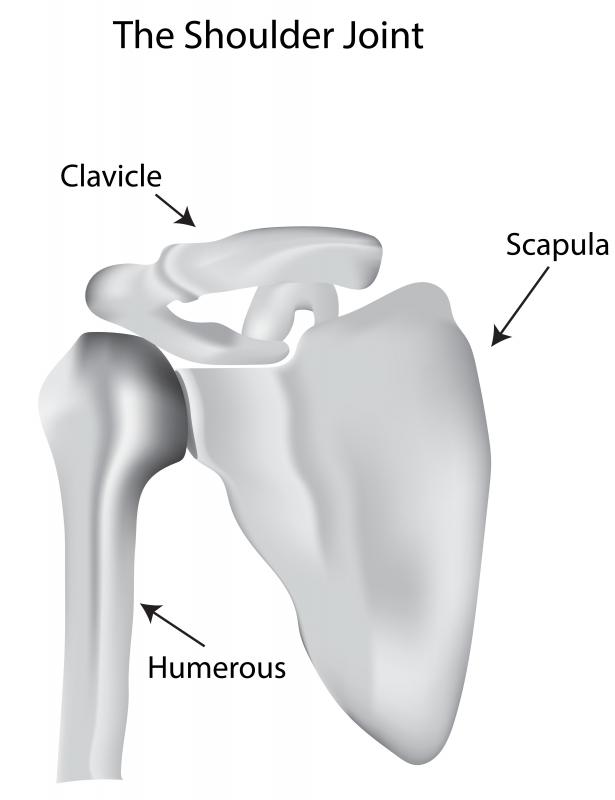At WiseGEEK, we're committed to delivering accurate, trustworthy information. Our expert-authored content is rigorously fact-checked and sourced from credible authorities. Discover how we uphold the highest standards in providing you with reliable knowledge.
What is the Coracobrachialis?
The coracobrachialis is a small, thin muscle located along the inside of the upper arm. It is so named because it attaches to the coracoid process of the scapula, a bony eminence that projects upward, outward, and slightly forward from the top outside edge of the shoulder blade. Though it is not as prominent on the arm as the biceps brachii, this muscle nevertheless serves several functions at the shoulder joint.
Originating on the peak of the coracoid process, a point of origin that it shares with the biceps as well as with the pectoralis minor in the chest, the coracobrachialis runs alongside the biceps muscle on the inside of the arm. It then inserts via a flat tendon beneath the biceps about midway down the shaft of the humerus bone. While the coracobrachialis muscle is not superficially very visible, its location can easily be determined as it is situated beneath the brachial artery, the largest blood vessel in the arm.

The coracobrachialis has two functions: flexion and adduction of the shoulder. Flexion of the shoulder involves raising the arm forward in front of the body, while shoulder adduction means pulling the arm inward toward the midline of the body when it is raised out to the side. This muscle is not a prime mover of the shoulder joint, meaning that other muscles are more heavily involved in performing these functions, but it does play a supporting role and therefore can benefit from strength training.

One exercise that strengthens the coracobrachialis is the incline cable chest fly. To perform the incline fly, one should set both pulleys on a dual cable column machine to their lowest setting and stand midway between them and slightly in front. Grasping a handle in each hand, he should bring both hands up and together in front of the chest, keeping the arms straight and drawing an inverted "V." Finishing with palms up and slightly turned in, he should slowly lower the arms down and out to the starting position, never locking the elbows.

To stretch the coracobrachialis, one should stand in a doorway facing outward with the right arm outstretched to shoulder height and palm pressed against the back of the door frame. He should then step slightly forward and turn his shoulders to the left so that a stretch is placed along the chest and the inside of the right arm. This stretch should be held for 20-30 seconds and repeated on the left arm.
AS FEATURED ON:
AS FEATURED ON:















Discussion Comments
The coracobrachialis is going to be of some concern to women, I think, or at least it is to me. It's situated on the underside of the arm, which is a place women often want to tone up.
It's important to try and strengthen all your muscles for health reasons anyway, but I can't help but also think that exercising this particular muscle will make me look prettier in a strapless dress.
@browncoat - I've had that happen to me, actually. Not with the coracobrachilis though. I've never actually heard of a coracobrachialis stretch before.
But, when I started exercising and stretching, I did some side stretches and thought they were quite easy, until the next day when the muscles there became quite sore.
I found that taking an ibuprofen tab helped a lot, since it's an anti-inflammatory.
I think though, if you get this kind of reaction, it's important to keep going, very gently, so you don't let the muscle stiffen up too much while you're waiting for it to get better.
If you do, the next time it will be worse.
Since this kind of muscle isn't probably used very much in your every day life, you should be careful with exercises which focus on it, at first.
Don't assume that just because they feel easy enough, they aren't doing some damage.
I suspect that often with this kind of muscle, the stronger muscles around it will support it during the exercise, but it still gets more stress than it's used to when targeted directly.
So, you can end up with a coracobrachialis strain in the end, which might not appear until the next day. And with any muscle involved in moving your arms, you don't want to strain them, because it can affect your daily life.
Post your comments